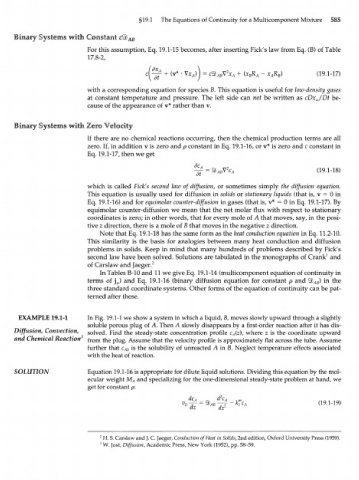Page 605 - Bird R.B. Transport phenomena
P. 605
§19.1 The Equations of Continuity for a Multicomponent Mixture 585
Binary Systems with Constant сЯЬ
АВ
For this assumption, Eq. 19.1-15 becomes, after inserting Fick's law from Eq. (B) of Table
17.8-2,
(v» • Vx ) = (x R - x R ) (19.1-17)
dt A B A A B
with a corresponding equation for species B. This equation is useful for low-density gases
at constant temperature and pressure. The left side can not be written as cDx /Dt be-
a
cause of the appearance of v* rather than v.
Binary Systems with Zero Velocity
If there are no chemical reactions occurring, then the chemical production terms are all
zero. If, in addition v is zero and p constant in Eq. 19.1-16, or v* is zero and с constant in
Eq. 19.1-17, then we get
(19.1-18)
dt
which is called Tick's second law of diffusion, or sometimes simply the diffusion equation.
This equation is usually used for diffusion in solids or stationary liquids (that is, v = 0 in
Eq. 19.1-16) and for equimolar counter-diffusion in gases (that is, v* = 0 in Eq. 19.1-17). By
equimolar counter-diffusion we mean that the net molar flux with respect to stationary
coordinates is zero; in other words, that for every mole of A that moves, say, in the posi-
tive z direction, there is a mole of В that moves in the negative z direction.
Note that Eq. 19.1-18 has the same form as the heat conduction equation in Eq. 11.2-10.
This similarity is the basis for analogies between many heat conduction and diffusion
problems in solids. Keep in mind that many hundreds of problems described by Fick's
second law have been solved. Solutions are tabulated in the monographs of Crank 1 and
of Carslaw and Jaeger. 2
In Tables B-10 and 11 we give Eq. 19.1-14 (multicomponent equation of continuity in
terms of ) ) and Eq. 19.1-16 (binary diffusion equation for constant p and ЯЬ ) in the
a АВ
three standard coordinate systems. Other forms of the equation of continuity can be pat-
terned after these.
EXAMPLE 19.1-1 In Fig. 19.1-1 we show a system in which a liquid, B, moves slowly upward through a slightly
soluble porous plug of A. Then A slowly disappears by a first-order reaction after it has dis-
Diffusion, Convection, solved. Find the steady-state concentration profile c (z), where z is the coordinate upward
A
and Chemical Reaction 3 from the plug. Assume that the velocity profile is approximately flat across the tube. Assume
further that c A0 is the solubility of unreacted A in B. Neglect temperature effects associated
with the heat of reaction.
SOLUTION Equation 19.1-16 is appropriate for dilute liquid solutions. Dividing this equation by the mol-
ecular weight M A and specializing for the one-dimensional steady-state problem at hand, we
get for constant p:
(19.1-19)
dz 2
2 H. S. Carslaw and ]. C. Jaeger, Conduction of Heat in Solids, 2nd edition, Oxford University Press (1959).
3 W. Jost, Diffusion, Academic Press, New York (1952), pp. 58-59.

